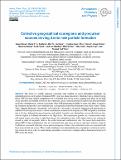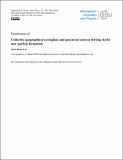Por favor, use este identificador para citar o enlazar a este item:
http://hdl.handle.net/10261/305088COMPARTIR / EXPORTAR:
 SHARE SHARE
 CORE
BASE CORE
BASE
|
|
| Visualizar otros formatos: MARC | Dublin Core | RDF | ORE | MODS | METS | DIDL | DATACITE | |

| Título: | Collective geographical ecoregions and precursor sources driving Arctic new particle formation |
Autor: | Brean, James; Beddows, David C. S.; Harrison, Roy M.; Song, Congbo; Tunved, Peter; Strom, Johan; Krejci, Radovan; Freud, Eyal; Massling, Andreas; Skov, Henrik; Asmi, Eija; Lupi, Angelo; Dall'Osto, Manuel CSIC ORCID CVN | Fecha de publicación: | feb-2023 | Editor: | European Geosciences Union | Citación: | Atmospheric Chemistry and Physics 23(3): 2183-2198 (2023) | Resumen: | The Arctic is a rapidly changing ecosystem, with complex ice–ocean–atmosphere feedbacks. An important process is new particle formation (NPF), from gas-phase precursors, which provides a climate forcing effect. NPF has been studied comprehensively at different sites in the Arctic, ranging from those in the High Arctic and those at Svalbard to those in the continental Arctic, but no harmonised analysis has been performed on all sites simultaneously, with no calculations of key NPF parameters available for some sites. Here, we analyse the formation and growth of new particles from six long-term ground-based stations in the Arctic (Alert, Villum, Tiksi, Zeppelin Mountain, Gruvebadet, and Utqiaġvik). Our analysis of particle formation and growth rates in addition to back-trajectory analysis shows a summertime maxima in the frequency of NPF and particle formation rate at all sites, although the mean frequency and particle formation rates themselves vary greatly between sites, with the highest at Svalbard and lowest in the High Arctic. The summertime growth rate, condensational sinks, and vapour source rates show a slight bias towards the southernmost sites, with vapour source rates varying by around an order of magnitude between the northernmost and southernmost sites. Air masses back-trajectories during NPF at these northernmost sites are associated with large areas of sea ice and snow, whereas events at Svalbard are associated with more sea ice and ocean regions. Events at the southernmost sites are associated with large areas of land and sea ice. These results emphasise how understanding the geographical variation in surface type across the Arctic is key to understanding secondary aerosol sources and providing a harmonised analysis of NPF across the Arctic | Descripción: | 16 pages, 6 figures, 1 table, supplement https://doi.org/10.5194/acp-23-2183-2023-supplement.-- Code and data availability: The code and data used to produce all non-illustrative figures are available from the corresponding authors under reasonable request. | Versión del editor: | https://doi.org/10.5194/acp-23-2183-2023 | URI: | http://hdl.handle.net/10261/305088 | DOI: | 10.5194/acp-23-2183-2023 | ISSN: | 1680-7316 | E-ISSN: | 1680-7324 |
| Aparece en las colecciones: | (ICM) Artículos |
Ficheros en este ítem:
| Fichero | Descripción | Tamaño | Formato | |
|---|---|---|---|---|
| Brean_et_al_2023.pdf | 5,66 MB | Adobe PDF |  Visualizar/Abrir | |
| Brean_et_al_2023_suppl.pdf | 3,04 MB | Adobe PDF |  Visualizar/Abrir |
CORE Recommender
SCOPUSTM
Citations
1
checked on 28-abr-2024
Page view(s)
46
checked on 30-abr-2024
Download(s)
30
checked on 30-abr-2024
Google ScholarTM
Check
Altmetric
Altmetric
Este item está licenciado bajo una Licencia Creative Commons

